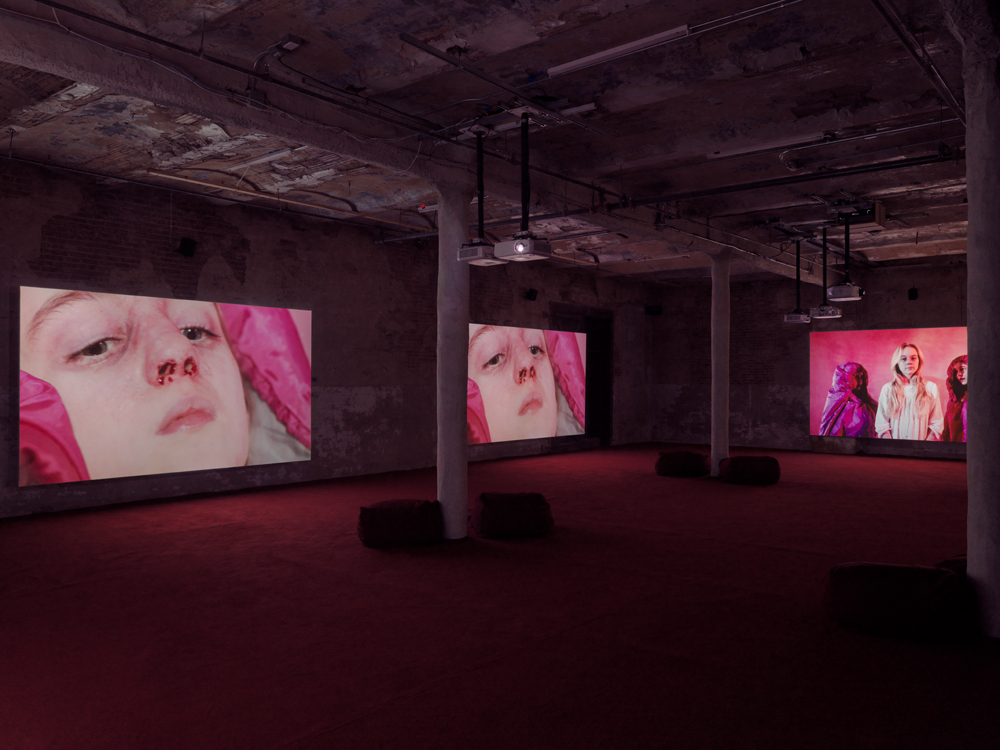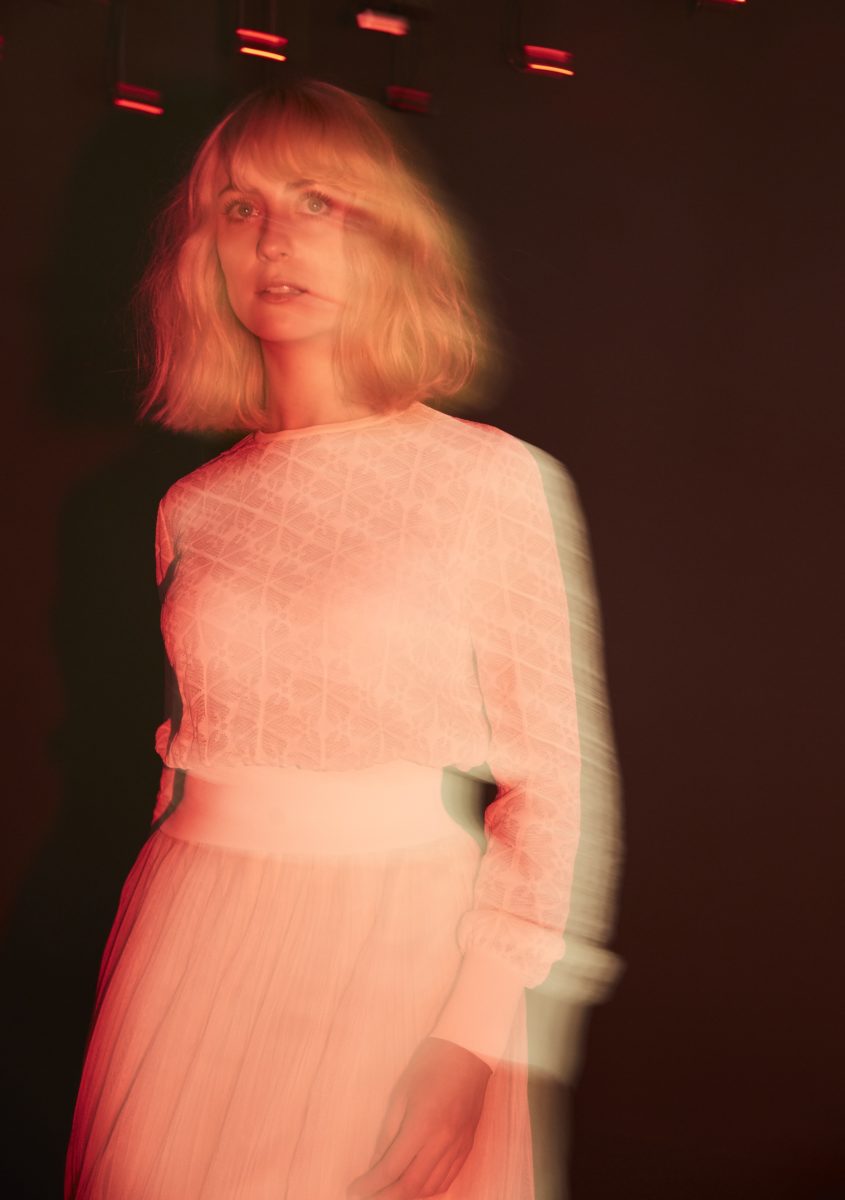Marianna Simnett On Her Latest Exhibition ‘Blood In My Milk’ At The New Museum
By Something CuratedIn her film, light, and sound-based works, London-based artist Marianna Simnett makes use of narrative structures and fantastical modes of storytelling, like fables, to guide a cast of characters through events that expose the subtle mechanics of violence and control that surround us. Her latest show, Blood In My Milk at New York’s New Museum, comprises new multi-channel edits of four of Simnett’s most important works to date. Experienced as a single storyline unfolding across five screens, Blood In My Milk chronicles Simnett’s exploration of organs, body parts, and infection through the lens of medical treatment and procedures. To learn more about Simnett’s practice and the thinking behind the current show, Something Curated spoke with the artist.

Something Curated: Your work seems to reject binary categorisations, such as innocence and cruelty, desire and revulsion, and even life and death – could you expand on this?
Marianna Simnett: I find those categorisations just fundamentally wrong. They don’t sit right with me, but then if you start to describe an alternative you can end up in a swamp. I try to be precise even when I’m overwhelmingly lost. Children are very cruel little creatures. People walk around in the city like the undead. The world is not made up of opposites, of male and female, black and white, gay or straight. That much seems obvious. Then it’s about inventing a new language and making it powerful enough to communicate.
SC: Do you find there is a guiding approach or ethos that tethers the different elements of your practice?
MS: Yes, I tend to purge. I ingest and digest a load of material, often from wildly different sources, dream and imagine every possible scenario, then it just kind of vomits out. My practice is like a ritual and I do it every day. The continuous effort of working autonomously has its own binding laws where all the elements are part of the same system however different they may seem up close.
SC: Can you give us some insight into your background? How did you enter this field?
MS: I started making drawings really early around 3 or 4, then played music from age 5. I was always the arty kid at school. Then I went to performing arts school and started acting, was never the best at that but it gave me a lot of confidence. My childhood was very scary, and I needed something early on that I could call my own. I was 14 when I saw Louise Bourgeois’ Turbine Hall work at the Tate, and I really couldn’t believe it was possible. I had had no reference point for so long, and finally I saw something that I could connect with one-on-one, without anyone telling me how.

SC: Can you talk to us about your new work, Blood In My Milk, showing at the New Museum?
MS: It’s a 73 minute, 5-channel video and surround sound installation. The story is about contamination and emancipation, told via narratives set in bucolic landscapes, surgical rooms, and cockroach laboratories. It contains nightmarish scenarios and invented illnesses. A young girl is told she is ‘too beautiful to play outside’, cockroaches are turned into biobots to save humans from disasters, teenage boys are given injections to deepen their voices. I am in the work too, hanging upside-down with blood pooling in my head, performing worm-curses and singing dreamy pop songs about paranoia and disease.
SC: With this work, what drew you to the lens of medical procedures?
MS: I’m always amazed by the transformative power of medicine. Several times I’ve been on medication, and still am, which drastically changes who you think you are. I’m really sensitive to bodies being cut and penetrated on screen, and still figuring out why the screen is able to reach you like that, turn you inside out so much. I also like the smoothness of procedures, their calm routine and the brimming violence which feels like it’s going to burst through any second. I use forensic viewpoints, endoscopic, impossible angles, trying to get closer to things we’re not allowed to see. And without wanting to sound like a sociopath, I like cutting up bodies, and describing them as fractured and incomplete.
SC: And what was the thinking behind the soundtrack in the space?
MS: The soundtrack is created with two exceptional talents, musician Lucinda Chua and sound designer Brendan Feeney at Wave Studios. Between us we have developed a unique sonic language for the work over the last four years. Every sound has its own logic within the story, like, what is the most convincing sound for valves or bones? There is a lot of world-building and pitch-bending, moments that slide from excruciating into delicious and heavenly. It’s designed as a 9.1 soundtrack specially for the space. Wherever you stand you’ll experience something different from the person on the other side.

SC: What was the process like working with curator Helga Christoffersen?
MS: Really great! We wanted this exhibition to be a radical new step in how I present my work. As a viewer you don’t go from A to B, it’s much more polymorphous than anything I’ve done before. We approached the space architecturally, to create a work that could breathe out loud — a singular experience comprised of millions of components.
SC: Are there any artists or people from different fields who have particularly influenced you in your career?
MS: In no particular order: David Bowie, Bruce Nauman, Ed Atkins, Maria Lassnig, Mica Levi, Mike Kelley, Hito Steyerl, Alexander McQueen, Donna Haraway, Marina Warner, Aphex Twin, Adrian Piper, David Cronenberg, David Lynch, Pier Paolo Pasolini, Robert Bresson, Agnès Varda, Claire Denis… this could go on a while. On a closer level, significant collaborators and brain-feeders: musician Lucinda Chua, writer Charlie Fox, curator Claude Adjil, and all the surgeons, farmers and creatures that show me new ways of thinking and being.
SC: How do you go about titling your works?
MS: They usually come at the beginning of a project and they help to anchor a pile of messy and uncontainable ideas. There is a simplicity to them, an obviousness, I hope, that they could be called nothing else. Just like a person gets completely attached to their name. I can’t squeeze them out, they normally come as a surprise, otherwise they feel forced and dull. Here are some of them: The Udder, Blood, Blue Roses, Faint with Light, The Needle and the Larynx, Wing-sleepers, Blood In My Milk.

SC: Living and working in London, what do you think is unique about London’s art scene? And what do you find the city offers artists?
MS: Free museums, expensive studios, pollution, stimulation, conversation.
SC: What are your favourite art spaces or cultural venues in London and New York?
MS: In London: Barbican Centre, Serpentine Galleries, Matt’s Gallery, Peckham Plex. In New York: Houdini Museum, The Kitchen, New Museum, Whitney Museum. I don’t know them so well though, I’m still learning the city.
SC: What are you currently reading?
MS: Mothers by Jacqueline Rose; Batman: The Dark Knight Returns by Frank Miller, which I found on the street; and Your Silence Will Not Protect You by Audre Lorde.
Marianna Simnett: Blood In My Milk at New Museum, 235 Bowery, NY 10002 | Open until 6 Jan 2019
Interview by Keshav Anand | All images courtesy New Museum